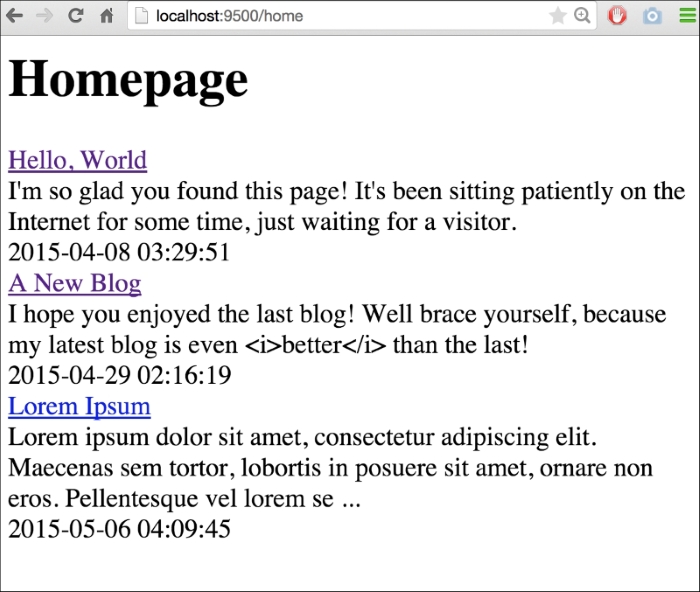Earlier in this chapter we looked at how we can use a range in our templates just as we would directly in our code. Take a look at the following code:
{{range .Blogs}}
<li><a href="{{.Link}}">{{.Title}}</a></li>
{{end}}You may recall that we said that Go's templates are without any logic, but this depends on how you define logic and whether shared logic lies exclusively in the application, the template, or a little of both. It's a minor point, but because Go's templates offer a lot of flexibility; it's the one worth thinking about.
Having a range feature in the preceding template, by itself, opens up a lot of possibilities for a new presentation of our blog. We can now show a list of blogs or break our blog up into paragraphs and allow each to exist as a separate entity. This can be used to allow relationships between comments and paragraphs, which have started to pop up as a feature in some publication systems in recent years.
But for now, let's use this opportunity to create a list of blogs in a new index page. To do this, we'll need to add a route. Since we have /page we could go with /pages, but since this will be an index, let's go with / and /home:
routes := mux.NewRouter()
routes.HandleFunc("/page/{guid:[0-9a-zA\-]+}", ServePage)
routes.HandleFunc("/", RedirIndex)
routes.HandleFunc("/home", ServeIndex)
http.Handle("/", routes)We'll use RedirIndex to automatically redirect to our /home endpoint as a canonical home page.
Serving a simple 301 or Permanently Moved redirect requires very little code in our method, as shown:
func RedirIndex(w http.ResponseWriter, r *http.Request) {
http.Redirect(w, r, "/home", 301)
}This is enough to take any requests from / and bring the user to /home automatically. Now, let's look at looping through our blogs on our index page in the ServeIndex HTTP handler:
func ServeIndex(w http.ResponseWriter, r *http.Request) {
var Pages = []Page{}
pages, err := database.Query("SELECT page_title,page_content,page_date FROM pages ORDER BY ? DESC", "page_date")
if err != nil {
fmt.Fprintln(w, err.Error)
}
defer pages.Close()
for pages.Next() {
thisPage := Page{}
pages.Scan(&thisPage.Title, &thisPage.RawContent, &thisPage.Date)
thisPage.Content = template.HTML(thisPage.RawContent)
Pages = append(Pages, thisPage)
}
t, _ := template.ParseFiles("templates/index.html")
t.Execute(w, Pages)
}And here's templates/index.html:
<h1>Homepage</h1>
{{range .}}
<div><a href="!">{{.Title}}</a></div>
<div>{{.Content}}</div>
<div>{{.Date}}</div>
{{end}}
We've highlighted an issue with our Page struct here—we have no way to get the reference to the page's GUID. So, we need to modify our struct to include that as the exportable Page.GUID variable:
type Page struct {
Title string
Content template.HTML
RawContent string
Date string
GUID string
}Now, we can link our listings on our index page to their respective blog entries as shown:
var Pages = []Page{}
pages, err := database.Query("SELECT page_title,page_content,page_date,page_guid FROM pages ORDER BY ? DESC", "page_date")
if err != nil {
fmt.Fprintln(w, err.Error)
}
defer pages.Close()
for pages.Next() {
thisPage := Page{}
pages.Scan(&thisPage.Title, &thisPage.Content, &thisPage.Date, &thisPage.GUID)
Pages = append(Pages, thisPage)
}And we can update our HTML part with the following code:
<h1>Homepage</h1>
{{range .}}
<div><a href="/page/{{.GUID}}">{{.Title}}</a></div>
<div>{{.Content}}</div>
<div>{{.Date}}</div>
{{end}}But this is just the start of the power of the templates. What if we had a much longer piece of content and wanted to truncate its description?
We can create a new field within our Page struct and truncate that. But that's a little clunky; it requires the field to always exist within a struct, whether populated with data or not. It's much more efficient to expose methods to the template itself.
So let's do that.
First, create yet another blog entry, this time with a larger content value. Choose whatever you like or select the INSERT command as shown:
INSERT INTO `pages` (`id`, `page_guid`, `page_title`, `page_content`, `page_date`)
VALUES:
(3, 'lorem-ipsum', 'Lorem Ipsum', 'Lorem ipsum dolor sit amet, consectetur adipiscing elit. Maecenas sem tortor, lobortis in posuere sit amet, ornare non eros. Pellentesque vel lorem sed nisl dapibus fringilla. In pretium...', '2015-05-06 04:09:45'),
Now, we need to represent our truncation as a method for the type Page. Let's create that method to return a string that represents the shortened text.
The cool thing here is that we can essentially share a method between the application and the template:
func (p Page) TruncatedText() string {
chars := 0
for i, _ := range p.Content {
chars++
if chars > 150 {
return p.Content[:i] + ` ...`
}
}
return p.Content
}This code will loop through the length of content and if the number of characters exceeds 150, it will return the slice up to that number in the index. If it doesn't ever exceed that number, TruncatedText will return the content as a whole.
Calling this in the template is simple, except that you might be expected to need a traditional function syntax call, such as TruncatedText(). Instead, it's referenced just as any variable within the scope:
<h1>Homepage</h1>
{{range .}}
<div><a href="/page/{{.GUID}}">{{.Title}}</a></div>
<div>{{.TruncatedText}}</div>
<div>{{.Date}}</div>
{{end}}By calling .TruncatedText, we essentially process the value inline through that method. The resulting page reflects our existing blogs and not the truncated ones and our new blog entry with truncated text and ellipsis appended:

I'm sure you can imagine how being able to reference embedded methods directly in your templates can open up a world of presentation possibilities.
